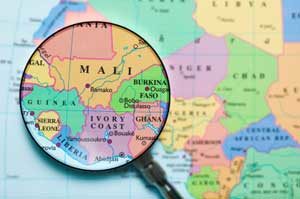Welcome to the WAEMM Blog.

Sierra Leone, officially the Republic of Sierra Leone, is a country in West Africa that is bordered by Guinea to the northeast, Liberia to the southeast, and the Atlantic Ocean to the southwest.
From Wikipedia, here is a little information about Sierra Leone:
Sierra Leone (![]() ,[4] officially the Republic of Sierra Leone, is a country in West Africa that is bordered by Guinea to the northeast, Liberia to the southeast, and the Atlantic Ocean to the southwest. Sierra Leone is a Constitutional Republic with a directly elected president and a Unicameral Legislature.
,[4] officially the Republic of Sierra Leone, is a country in West Africa that is bordered by Guinea to the northeast, Liberia to the southeast, and the Atlantic Ocean to the southwest. Sierra Leone is a Constitutional Republic with a directly elected president and a Unicameral Legislature.
The country has a tropical climate, with a diverse environment ranging from savannas to rain forests. The country covers a total area of 71,740 km2 (27,699 sq mi)[5] and with an estimated population of 6 million (2011 United Nations estimate).[1][2]
Sierra Leone is divided into four geographical regions: the Northern Province, Eastern Province, Southern Province and the Western Area; which are subdivided into fourteen districts. The districts have their own directly elected local government known as district council, headed by a council chairman. Freetown is the capital, largest city as well as its economic, commercial and political centre.
Sierra Leone has relied on mining, especially diamonds, for its economic base. The country is among the largest producers of titanium and bauxite, and a major producer of gold. The country has one of the world’s largest deposits of rutile. Sierra Leone is also home to the third largest natural harbour in the world, where shipping from all over the globe berth at Freetown’s famous Queen Elizabeth II Quay. Despite this natural wealth, 70% of its people live in poverty.[6]
Sierra Leone is a predominantly Muslim country,[7][8][9] though with an influential Christian minority. The population of Sierra Leone comprises about sixteen ethnic groups, each with its own language and custom. The two largest and most influential are the Temne and the Mende. Although English is the language of instruction in schools and the official language in government administration, the Krio language (derived from English and several indigenous African languages) is the primary language of communication among Sierra Leone’s different ethnic groups, and is spoken by 90% of the country’s population.[14] The Krio Language unites all the different ethnic groups, especially in their trade and interaction with each other.[15]
In 1462, the area that is now Sierra Leone was visited by the Portuguese explorer Pedro de Sintra, who named it Serra Leoa, meaning “Lioness Mountains”.[16][17] Sierra Leone later became an important centre of the transatlantic trade in slaves until 11 March 1792 when Freetown was founded by the Sierra Leone Company as a home for former slaves enslaved from (or freed by) the British Empire.[18] In 1808, Freetown became a British Crown Colony, and in 1896, the interior of the country became a British Protectorate.[19] Between 1991 and 2002 the Sierra Leone Civil War devastated the country leaving more than 50,000 people dead, much of the country’s infrastructure destroyed, and over two million people displaced in neighbouring countries as refugees.
(From Wikipedia on May 3, 2013)

Dr Karen ,
Our thoughts and prayers are with you. You would not be human if you weren’t a little fearful! And God knows that— it’s why he said ” Do not be afraid” so many times in scripture. I know God’s got this! I pray he gives you that peace that passes all understanding. We love you and Dr Tom.
Lenore and Ken Rose